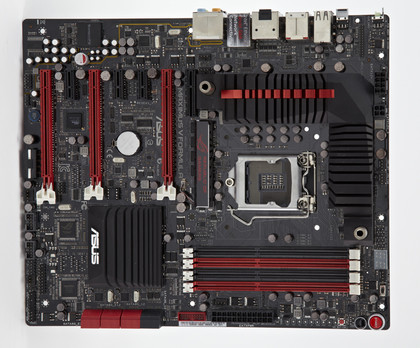TechRadar Verdict
Pros
- +
Packed with features
- +
Pre-fitted blocks for liquid cooling
- +
Good auto-OC results
Cons
- -
Price
- -
No real performance difference to standard boards
Why you can trust TechRadar
The Republic of Gamers (RoG) has come out firing on the Intel Z77 chipset once again with the Asus RoG Maximus V Formula. This is a high-end motherboard with hardcore overclocking pretensions.
It has an Extended ATX format, making it a rather large board, replete with blocks that are ready for liquid-cooling over the power circuitry, and voltage report points by the board-mounted power and reset switches.
Asus has also shoe-horned as many extras into the RoG Maximus V Formula as it can manage, with the possible exception of the forthcoming ThunderBolt add-in card to make nice with Intel and Apple's new interconnect.
That's not the card Asus tried to foist on us before. Gone is the Xonar sound card/BigFoot NIC combo we saw in the Asus RoG Rampage IV Extreme. There's 7.1 SupremeFX audio, with integrated headphone amp and a mini PCIe combo card incorporating two slots for mSATA and a dual-band Wi-Fi card. There's also an extra ASMedia USB 3.0 controller, adding an extra pair of ports to the back panel.
Gamers?

But this is a Republic of Gamers board, so forget all the angular water blocks and shiny extras. What we really want to know is how it performs.
We have a bit of a problem with the RoG brand from Asus. Originally, as the name would suggest, it seemed to be a brand containing the very highest performing boards with a view to getting the highest frame rates in-game.
It's got to the stage now with the limits Intel has placed on CPU overclocking - where the multiplier is your only real course of action - that even the straight Asus boards, such as the P8Z77-V Pro, are capable of some of the fastest frame rates around.
Sign up for breaking news, reviews, opinion, top tech deals, and more.
What does that all mean for the scores on the doors for the Asus Maximus V Formula? Compared with the Sabertooth Z77 at stock speeds, the RoG board does have a slight advantage. That said, 0.13 of a frame per second in-game between the two boards doesn't really add up to the extra £130 Asus wants you to pay for the red highlights and RoG branding.
In the overclocking stakes, things are slightly different. The auto-overclocking of the two boards has the Sabertooth topping out at 4.2GHz and the RoG at 4.6GHz. Still, you can just push the multiplier up to x47 and the Sabertooth will run just fine at 4.7GHz.
Benchmarks
Stock performance
Cinebench R11.5: Index score: Higher is better
ASUS ROG MAXIMUS V FORMULA: 7.99
ASUS SABERTOOTH Z77: 7.91
Auto OC performance
x264 v4.0: Frames per second: Higher is better
ASUS ROG MAXIMUS V FORMULA: 51
ASUS SABERTOOTH Z77: 47
Maximum OC performance
Shogun CPU: Frames per second: Higher is better
ASUS ROG MAXIMUS V FORMULA: 48
ASUS SABERTOOTH Z77: 47
With a little judicious voltage tweaking you can get the RoG up to 4.8GHz, but that will give you precious little gaming advantage. I expect that you can get some impressive overclocking numbers with the BIOS in LN2 mode and a flask of the chilly stuff, but you're not going to be doing that for gaming. That's all for the Republic of LN2 sniffers, not Gamers.
When the average PC tweaker could get much better performance out of their RoG boards, they were relevant. With the performance of Asus' own Sabertooth and Pro boards though, there's little justification for spending the extra money.
